- Know what to see in Pachmarhi, their
cultural significance, caves dedicated to Shivji and ideas how Madhya Pradesh
Tourism can make the trip to the Queen of Satpura Range more memorable.
Pachmarhi (1,100 metres) is also known as
the Queen of the Satpura Range and is the highest point in Madhya Pradesh. It
is about a four-five hour drive from Nagpur, Maharashtra and Jabalpur/Bhopal,
Madhya Pradesh with Bhopal being the shortest distance in kms. It is 54 kms
from Pipariya railway station.
We drove in from Jabalpur where we saw Marble
Rocks, Chausath
Yogini Mandir We missed going to Amarkantak
from Jabalpur, source of the holy river Narmada.
Pachmarhi must be one of the most peaceful “hill stations” I have ever visited and probably one of the few which has so many places of worship, all of which still have a rustic feel. Pachmarhi is for those who wish to avoid crowds and like walks.
When one goes to Pachmarhi, tour guides and hotel operators usually suggest a two day program. The first is a “Falls tour” and the second a “Temple tour”. The day wise classifications implies that on day one, tourist visits a couple of waterfalls and scenic places and on day two, Temple caves. Almost all the places involve some walking and climbing so be prepared.
The forests around Pachmarhi are part of
the Satpura National Park. Also read Leopards
of Satpura Tiger Reserve
The Pandavas lived here during their exile
and excavated five caves (panch marhi) hence the name. Here are the places we
visited.
1. Museum
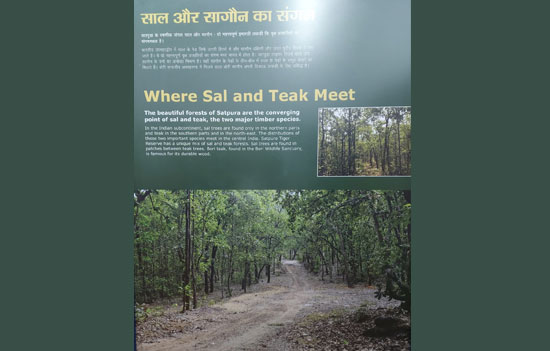
It is probably one of the smallest museums
I have been to and displays photographs of what to expect in Pachmarhi. Here
you get the permit to enter the forest zone. Also visit shop that sells T-shirts,
caps, etc. Purchase is a way to support the local population.
2. Pandav Gufa
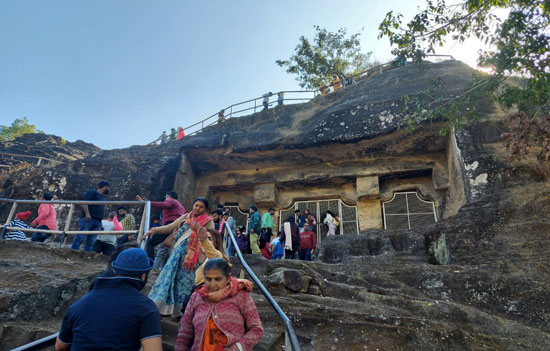
The Pandav Caves are believed to be caves
in which the Pandavas meditated but modern archeologists believe that Buddhist
Monks meditated in these caves and they have no connection with the Pandavas. The
five caves are on two levels and children are very excited to climb and reach
the top of the caves. There is a small well-maintained garden at the bottom of
the Gufa where some beautiful flowers have been planted.
3. Bee Waterfalls
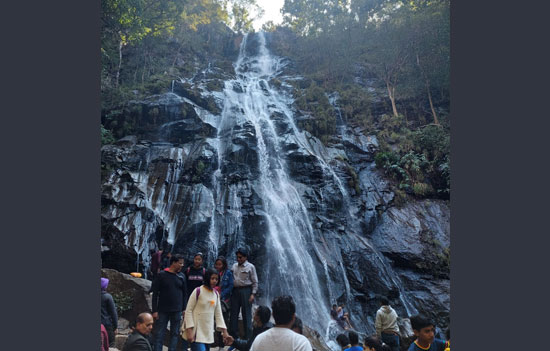 Bee Waterfalls
Bee Waterfalls
After the climb to the Pandav Gufa, one makes ones way to the biggest falls in Pachmarhi – the Bee Falls. The water here is sparkling pure and it is this water which makes its way to the kitchens of Pachmarhi. Before we reach the falls, there is a flatter falls leading to a flowing brook and many people sit here and dip their legs in these waters.
The way to Bee Falls is about 400 steps
down. The steps are uneven and the side railings are there for most of the
steps. We were advised to carry spare clothes if we were interested in having a
dip there, but on reaching the place we realized
that there was absolutely no place to take a dip. Couples try to take a
bath at the bottom of the falls by crossing uneven boulders to reach there.
Since many couples want to do this, every couple can sit under the falls for a
maximum of 5 minutes. There is no flat land to sit down and enjoy the view and
in fact the space at the bottom of those 400 steps is too less to accommodate
even 100 people.
Since only one spot is the best for
clicking photos, almost all the tourists throng to that spot & I was
reminded of visiting our famous Temples because one can stand there for only
about two minutes per couple/family before being told to move ahead and make
space for the next photo session.
The climb up is equally tortuous and
unfortunately there is seating space for 1 person in 2 places only. This place needs to be made tourist
friendly.
Disappointed with Bee (may be best time to
visit is during or post monsoons) we skipped visiting Apsara Vihar and Silver
Falls (or Rajat Prapat that falls from a height of 350 feet).
4. Reechgarh
 Route to Reechgarh. Youngsters loved it.
Route to Reechgarh. Youngsters loved it.
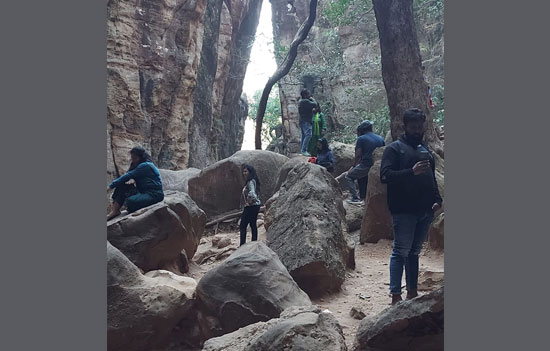
Youngsters and those young at heart will
love the ruggedness of this place. Reech
is Bear in Hindi and it is believed that this place is the abode of bears.
There is a natural cave formation among the rocks and walking through the rocks
gives one a sense of adventure.
The rocks and trees around the area seem
to have seen many centuries and it is just the place one goes to while trekking
or on a holiday.
5. Dhoopgarh is sunset point 1350 meters
Dhoop is
sunlight in Hindi. Like every hill station Pachmarhi has its Sunrise and Sunset
points. Dhoopgarh is that place. Absolutely beautiful views and it was a
pleasant surprise to see steps for seating at the sunset point. One could sit
there, soak in the view and enjoy the beautiful weather without any fear of
monkeys or beggars troubling one. Actually, I did not see a single beggar in
Pachmarhi.
On the way to Dhoopgarh, there is a
diversion which leads to Naagdwari.
One has to walk 12kms in the dense forest to reach this place and devotees from
Maharashtra come here every year during Shravan Maas to have darshan of Mahadev
and Naga Devata in this Temple. States are a post 1947 creation, cultural ties
span centuries.
6. Bada
Mahadev Cave
 Inside Bada Mahadev.
Inside Bada Mahadev.
On the Temple Tour, the first place we
visited was Bada Mahadev cave on Mahadev Hills. One has to walk a very short
distance from the parking area to the cave. Droplets of water keep falling
continuously on your head as you walk inside the cave to reach the Shivling.
The local caretaker/Priest of the Temple was missing but we were very grateful
to him because care had been taken to fill some drums with water which could be
used to do Jal-Abhishek to Mahadev.
At the entrance of the cave are some huge Trishuls.
A very serene feeling overcame us as when we were in the cave.
7. Gupt Mahadev Cave and
Chauragarh
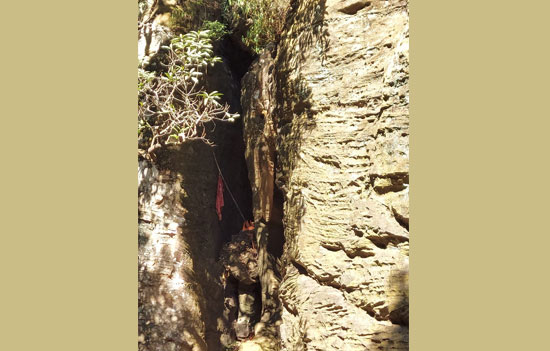 Entrance way to cave.
Entrance way to cave.
From the Bada Mahadev, one can walk a
short distance to the Gupt Mahadev cave. At the entrance of the cave is a huge
Hanuman Murti. There is a walk of about 40 feet, in a very narrow path that
takes you inside of the cave where a Shivling is worshipped.
Since only one person can walk between the
two cave walls, sometimes there is a queue to enter the cave. Here too, one can
do Jal-Abhishek from the stored
water, if available. There was no Priest inside when we visited the cave. On
the path to the cave some adivasis sell Datura flowers, fruit and Bael leaves
which are offered to Mahadev.
From here, many people walk about 3.5 kms
in the forest or climb about 1300 uneven steps to reach Chauragarh. In
Chauragarh too Mahadev is worshipped. Here devotees pray for their wishes to be
fulfilled. When fulfilled, they express their gratitude to Mahadev by keeping a
trishul in the temple.
8. Jatashankar Mahadev Cave
 Trishul at entrance to cave.
Trishul at entrance to cave.
From the Gupt Mahadev Cave we made our way
to Jatashankar Mahadev. All the three Temples mentioned are associated with the
story of Mahadev and Bhasmasura.
Bhasmasura was an Asura who meditated on Shivji for many years and asked Shivji for an unusual boon–that if he touched the head of a person or animal, that person or animal should become ashes. Shivji granted him the boon only to regret it because Bhasmasura now wanted to put his hand on the head of Shiva even though Shivji could have burnt Bhasmasura into ashes right there, He did not do so but tried to escape because Mahadev never interferes in the law of Karma.
Shivji hid in these caves to avoid
Bhasmasura but finally had to approach Maha Vishnu to help to destroy Bhasmasura.
Thus, Maha Vishnu took the form of the beautiful Mohini and enticed Bhasmasura
into a dance competition with Her, saying that if he won, he could marry Her.
In the course of the dance, Mohini puts Her hand on Her own head and Bhasmasura
does the same and that was the end of the Asura who became Bhasma or ashes
himself. Chauragarh is associated with this final act.
In the Jata Shankar Mahadev cave, we see
formations which resemble the Jata (hairlocks) of Shiva. It is believed that
Shiva gave up some of His Jata there. There is a continuous flow of fresh water
within the cave and this water is offered as Abhishek to Mahadev there.
The path leading out of the cave is
beautiful and the entire walk into and out of the cave is enthralling.
One has to walk about 600 metres before
reaching the cave and on the way is a little temple where we find 2 floating
rocks which are believed to have been those used to build the Rama Setu in
Rameshwaram. A Sadhu had brought it from there and kept it in this little
Temple.
The rocky mountain trail exposed us to
lots of honeycombs high on the walls of the mountains and there are many shops
selling the honey, supposedly collected by local adivasis.
Pachmarhi is famous for its jungle honey.
It is also famous for many Ayurvedic medicines. One can also buy sarees with
local prints here. Mrignayanee is a state government store that sells local
handlooms and goods produced by adivasis.
“Prehistoric rock paintings have been discovered in some of the caves near Pachmarhi, such as Astachal (Monte Rosa), Harper’s Cave, Dhuandhar Cave, etc.”
Feedback for Madhya Pradesh
Tourism
While the rustic beauty of Pachmarhi
cannot be denied, MP Tourism has to provide more amenities to tourists.
There are no toilets at many of the sites
and even where toilets exist they are not clean. Secondly, there is a severe
shortage of good hotels. There are a miniscule number of stalls which offer
some basic food like Maggi noodles, but they are shabby and just a tent. There
is no place to sit comfortably and eat.
On the positive side, I did not see much
trash being thrown about because tourists and the guides/drivers/hotel staff,
etc. all make it a point to keep warning tourists not to litter. Though I did
read about a Tiger Safari in the forests of Pachmarhi, no hotel staff or
tourist taxi/gypsy driver recommended it at all. This was a little surprising.
Stay
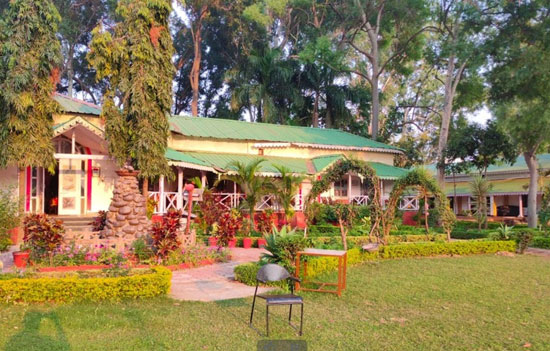
We stayed at Highway Resorts. Pachmarhi has many good hotels and resorts. MP Tourism have two properties namely MPT Amaltas
and Champak
Bungalow
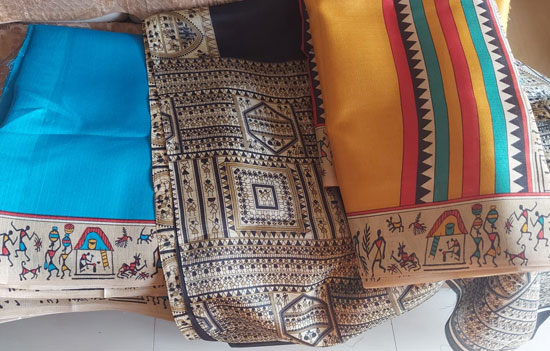 Bought these jute silk saris from MP Tourism store.
Bought these jute silk saris from MP Tourism store.
Author
Rati Hegde is a serious student of Bharatiya Samskriti, author and columnist on Indic matters. She visited Jabalpur, Pachmarhi with her family in December 2022.
To read all articles
by author
To read her articles on Pragyata
Also
read
1. Explore Pachmarkhi – the road less travelled
2. Madhya Pradesh
Tourism site to know about Pachmarhi